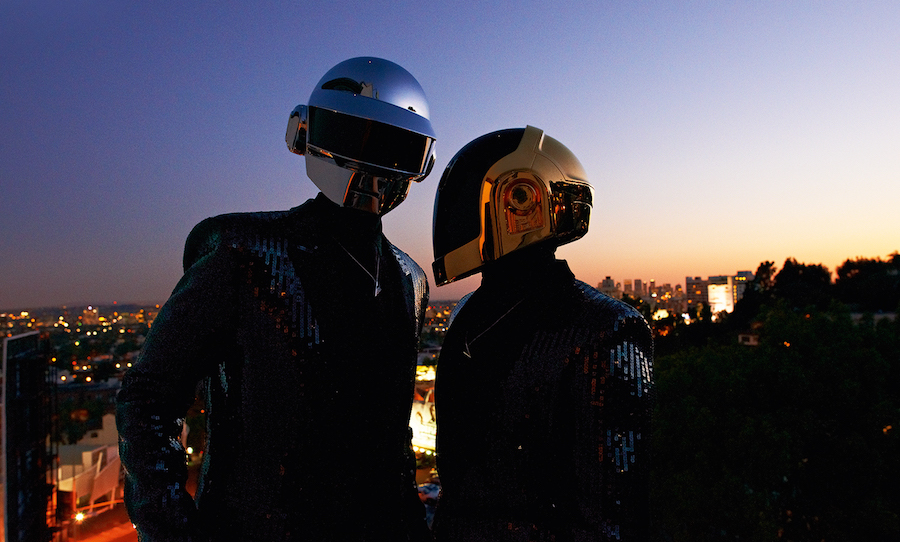The human voice is the world’s oldest instrument, and in terms of tone and distinction it is truly unparalleled. It’s not surprising then that over popular music’s short but sweet history, engineers have created devices for voice alteration – for better and sometimes for worse. Talkboxes, vocoders and auto-tune; each of these strange devices has had a chequered history, facing long roads to find acceptance in pop.
 Humans have been singing for millennia, so it’s unsurprising that the development of music technology has birthed numerous ways for voice alteration.
Humans have been singing for millennia, so it’s unsurprising that the development of music technology has birthed numerous ways for voice alteration.
Early Developments: The Talkbox
The talkbox does not actually alter the sound of the human voice per se. Instead it takes the frequency content of vocal ‘sounds’ and applies it to an instrument. Amateur radio operator and Gibson engineer Alvino Rey made the first developments with the technology in 1939 when he taped a military-developed carbon microphone to his wife Luise King’s throat (no doubt she had a lot of patience).
Luise was one of the King Sisters, a big band-era swing group, so she had some vocal chops behind her. The couple would perform together, with Luise standing behind a curtain or partition, singling softly, while her husband played guitar. The result was an interesting wah-wah-esque sound, where one could almost make out some lyrics through the guitar licks. But as curious as it was, the technique fizzled out, written off as something of a novelty.
Gilbert Wright invented a similar product for Sonovox, also in the late 1930s. The idea suddenly struck him one morning as he used his electric razor. Wright’s wife called to him with a question and as he ran the buzzing razor down his throat, he yelled back: “What did you say, honey?”, his voice humming and wurring. So inspired he was, that he began to chase a device to replicate the effect.
Wright used tiny transducers, attached to a singer’s throat to pick up their mouth-modulation. This method was more practical, and found some popularity in radio jingles and film themes. The Who even used a similar technique on their 1967 album The Who Sell Out, where the days of the week are ‘sung’ through an organ.
Steel guitar legend Peter Drake used another early example of a talkbox for many of his albums during the 1960s, including his 1964 record Forever. His device used an 8-inch paper cone speaker, attached to a tube, which he would mouth his words into. The device was relatively portable, however, the gain produced was only substantial for studio work.
The Kustom Electronics talkbox, also known as ‘The Bag’, was the first mass produced talkbox. It used a 30-watt driver and was slung over the shoulder in a decorative bag that looked very much like a leather water bladder.
Claimed to have been invented by Doug Forbes, The Bag used an ‘artificial larynx’ – a speaker attached to a plastic tub, which was inserted into the users mouth. The unit was released in 1969, and despite its strange appearance, it became popular with psychedelic rock bands of the time, such as Iron Butterfly (see video below, around 13 minutes in) and Steppenwolf, who incorporated trippy mouth sounds into their live and studio performances.
The talkbox also found some love with early funk acts like Sly and the Family Stone and Stevie Wonder, who used The Bag on his 1972 album Music of My Mind
Sound engineer Bob Heil, who worked for the Grateful Dead in the absence of Stan Owsley, developed perhaps the most useable version of the talkbox. Created for Joe Walsh’s Barnstorm tour, Heil’s contraption combined a 250-watt JBL driver with a hi-pass filter. Needless to say there was plenty of power and plenty of tone.
Peter Frampton became particularly smitten with the piece of gear after hearing Peter Drake use it during an Abbey Road studio session. Frampton received a 100-watt hand-built fibre glass version as a generous Christmas present from Heil, which was essentially a pedal effect. He immediately began practising with it – in fact, it’s rumoured that Frampton locked himself away for two weeks to master the new effect. His iconic performance of Do You Feel Like We Do, which features a talkbox solo, saw him become synonymous with the instrument.
Heil sold the manufacturing rights to his talkbox in 1988 to Dunlop Manufacturing Inc, who continue to produce it in the same specifications to this day.
Pushing Forward: The Vocoder
The vocoder did not have such a Romantic upbringing. The unit was originally created for telecommunications purposes as a ‘Voice-coder’, from which the name ‘Vo-coder” was derived (smart right?).
Bell Labs engineer, Homer Dudley originally intended the vocoder to be used to transmit messages over long distances such as the Trans-Atlantic telephone cable. The idea was to decode and compress human speech, so that the message would take up less bandwidth along the primitive copper wires. The signal had to be stripped back to the essential, recognisable sounds to reduce the transmission time.
The Trans-Atlantic vocoder never saw the light of day before Dudley filed a patent in 1939, just in time for the Second World War. The military picked up on the technology very quickly, finding it an effective way to disguise messages from enemies. Belle Labs called it Project X, and the US, the slightly less sinister, SigSally.
12 massive terminals were created during the war, which spanned Europe and The Pacific, each station taking up around 200 square metres of floor space requiring numerous operators. Military operators took classified messages and scrambled them, adding noise from turntable records. At the other end, the receivers would deduct the noise, decode, and then reconstruct the message. The innocent vocoder, originally planned to improve communication, became a vital part of wartime communication, and was used to plan the devestating nuclear bombing of Hiroshima.
The Vietnam War saw improvements in the technology, which included algorithms that would predict what the speech would do, allowing for the message to be received and replicated more accurately. This technology would continue to be developed, eventually, find its way into mobile phones. That iPhone in your pocket? Technically a vocoder.
After the Second World War, there were various attempts at repurposing the vocoder for music. One of the first was the Siemens Synthesiser, created by Siemens in the late 1950s. In 1968 Robert Moog developed one of the world’s first music-purposed vocoders, a solid state unit that would go on to feature in the soundtrack for 1971’s A Clockwork Orange.
The 1970s saw the vocoder more widely adopted in the arts, it continued to be a popular choice in sci-fi films, especially when a robot needed to speak. As the decade progressed, popular music began to adopt new types of synthesisers and looked to technology to create futuristic sounds. Kraftwerk were one of the first commercially successful artists to use a vocoder. The band implemented a Sennheiser VSM 201 throughout many of their songs and introduced the strange tool to many young artists.
Progressive rock acts also picked up on the instrument, including the Alan Parsons Project, who used it on Tales of History and Imagination, and Pink Floyd’s, employing it on their seminal 1977 album, Animals (you can hear it on Dogsand Sheep).
The 1980s saw the vocoder continue to gain momentum when it was adopted by new wave artists such as New Order and early hip-hop acts like Nucleus and Afrika Bambaataa, 1982’s Planet Rock being a prime example. These artists were already experimenting with drum machines and bass synths to create completely fresh sounds on mostly electronic instruments, and the vocoder was a welcome addition to their musical pallet.
In modern times, Daft Punk have arguably been the most consistent users of the vocoder, from 1997’s Around the World to 2013’s Get Lucky. The duo consider the instrument vital in their sonic identity and their man vs machine thematics.
Auto-Tune & The Modern Age
Auto-tune brought voice alteration into the 21st century. A product of the computer era and the move towards DAWs, auto-tune was developed by Antares Audio Technologies. The software was initially created to assist artists with pitching, auto-correcting slight errors and nudging them to the nearest semitone, so the singer seemed perfectly in key. Producers recording vocals soon found that the tool could also be used to manipulate voices with dramatic warbling pitch-shifting effects.
Auto-tune was first developed in 1997, and its first commercial use, Cher’s 1998 Believe, is a perfect example of some of its signature mechanical-modulations. The effect was created by using an especially aggressive setting so that the pitch was corrected at the very moment that the signal was received. After the success of the single, it became known as the ‘Cher effect’ and her producers were very secretive about how they achieved it, claiming that they had used a talk box or a vocoder in an attempt to preserve what they felt was a trade secret.
Some producers saw the new technology as a sigh of relief as it allowed them to craft perfect vocals takes, saving time in the studio and during post production. The technique was adapted for live shows with the use of rack units, and as the turn of the millennium rolled around, it had spread throughout all facets of popular music.
Unsurprisingly, the effect also earned itself its fair share of opposition by those who point out that it makes it possible for anyone to sound on-key. At the 51st Grammy Awards, alternative rock band Death Cab for Cutie launched a protest campaign against auto-tune, wearing blue ribbons while they performed.
Ellie Golding and Ed Sheeran have also recently started ‘Live Means Live’, a campaign scrutinising the use of voice editing in live performances. Even media channels have faced backlash against the technology. A scandal in 2010 saw American Idol caught out for using auto-tune on their contestant’s voices, eventuating in judge Simon Cowell ordering a ban for all future episodes.
Despite the controversy surrounding the technology, it has found unique uses that have become a signature sound for many recording artists, such as R&B singer T-Pain. One of the first to embrace the technology in his genre, T-pain has stated that he has been inspired by 1960s era soul music claiming in an interview with Mashable, “I thought I might as well just turn my voice into a saxophone.” T-Pain has gone onto launch an app for the technology, which has been downloaded millions of times since: “I said, ‘Well, I guess I’m so famous for the auto-tune, I guess I should make an app.”
Even voice-changing veterans Daft Punk haven’t been immune, receiving a few raised eyebrows for their use of auto-tune on their single ‘One More Time’. However in an interview with Remixmag, Thomas Bangalter waved off the criticism, stating that with all new technologies there are people who are skeptical, and that the important thing is to continue finding new and creative applications.
“A lot of people complain about musicians using Auto-Tune. It reminds me of the late ’70s when musicians in France tried to ban the synthesiser… What they didn’t see was that you could use those tools in a new way instead of just for replacing the instruments that came before.”


